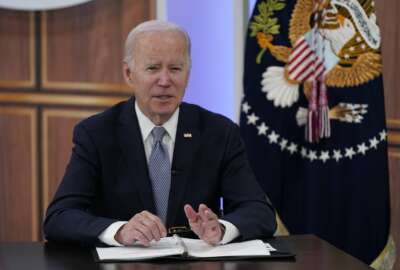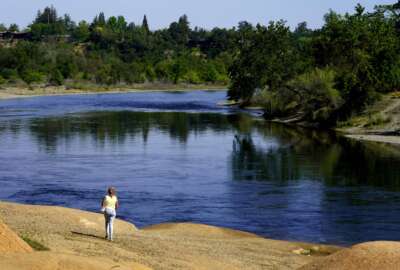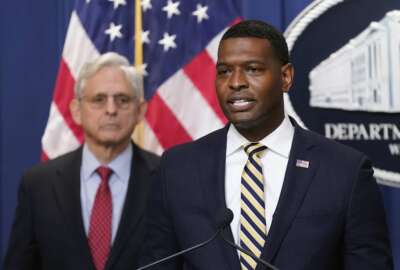New HHS challenge prize program seeks to improve local environmental justice
The Health and Human Services Department (HHS) has launched a new challenge. It is seeking what it calls community-level solutions for health inequities. Prizes...
The Health and Human Services Department (HHS) has launched a new challenge. It is seeking what it calls community-level solutions for health inequities. Prizes will total a million dollars. For how it works, the Federal Drive with Tom Temin talked with the Interim Director of the HHS office of Environmental Justice, Sharunda Buchanan.
Interview Transcript:
Tom Temin Well, tell us what you’re trying to achieve here with this challenge prize program.
Sharunda Buchanan We really here at the Office of Environmental Justice want to be a resource to communities for far too long many disadvantaged communities and tribes have faced the brunt of injustices, including harms to climate change. Many of your listeners may be aware of the Flint, Michigan water crisis. These are the kinds of injustices and issues and harms that communities have been needing to actually address in their communities for a very, very long time. And so this Office of Environmental Justice that was established last year really want to be a resource communities to help them to address these injustices. We say that climate change is a fact multiplier. It exacerbates many of these environmental burdens and environmental hazards that communities have been exposed to and had to contend with for a very long time. So the challenge is a chance for community and tribal voices to share their own approaches in improving public health, reducing pollution, and addressing local climate change impacts.
Tom Temin Well, give us an example of like where a climate change say things are getting warmer and there’s greater flood possibilities in some areas or whatever the case might be. Give us an example of how that might affect a particular area or a particular group of people more than others, say, in adjacent areas.
Sharunda Buchanan I want to give you an example of Lowndes County. It’s a county in Alabama that have been plagued with water infrastructure problems. I mean, there’s water, sewage, etc.. Yeah, sort of in backyards, in front yards. You know, when they’re climate change issues and flooding issues, it will exacerbate something of that sort. So water infrastructure is very, very important. And it’s important for folks to have clean water to actually sort of live in a health and equitable manner. I always like to say that health equity as we pursue health equity and environmental justice, those two things are inextricably linked. So again, we want to hear from communities. Communities have their own challenges and they know some of their solutions to them. So we want to uplift those voices with this challenge.
Tom Temin And how does the challenge work? That is, suppose let’s take that same county as an example. They have problems where their freshwater system is in danger of being contaminated by their wastewater system, and that can be exacerbated by floods and so forth, which moves things around in a way you don’t want to. What could be some possible solutions and who locally might be able to do that? And if they felt they could, what would they do in relation to this particular challenge?
Sharunda Buchanan The challenge actually has two phases. All eligible entries will be evaluated and separate prizes will be awarded for each of the two phases. So for phase one, it will focus on design of an innovative concept to enhance community driven efforts to mitigate health disparities and of course, to advance health equity or the development of an effective approach. You know, there’s also going to be phase two, which consist of small scale testing or implementation of a well developed approach or a community led effort to mitigate, of course, the health disparities and advance health equity as well. I want to just sort of pause here and mention for your listeners that we just launched this challenge September 18th, 2023, and we’ll be receiving and taking in entries through January 30th, 2024, and for entries in phase two that will begin in 2024. So we want participants and this is open to individuals, community based organizations, tribes, tribal organizations, local state governments. I mean, it is really open for profit, nonprofit communities, if you will, because they know their issues best. So we want to uplift those voices as they provide solutions.
Tom Temin We’re speaking with Dr. Sharunda Buchanan. She’s interim director of the Office of Environmental Justice at the Health and Human Services Department. And some of the problems here, whether it’s maybe buying air conditioners. You know, often impoverished areas suffer the heat worse than the wealthier areas simply because of lack of air conditioning. But fixing that is real money. I mean, the Congress appropriated a trillion dollars not long ago for infrastructure. Can the prize winners be eligible for funding at the grant level to actually carry out programs that are going to be a lot more expensive than the prize money will yield?
Sharunda Buchanan So the challenge itself is a little bit different from what I think you are referring to as sort of our traditional way of funding communities. I mean, this is a way to really get into the hands of, like I said, individuals or community based. Organizations or, you know, a group of entities, if you will, to really think about how they can sort of provide a solution to their own issues. We’re hoping to accomplish again and find out sort of what the goals are of each of those communities. And they provide those solutions if you will. It’s one part of our multi-pronged approach to promoting health equity, environmental justice for all. I also want to say that, you know, in terms of meeting our goals here, to be a resource to those communities, this is one thing that we could do to really sort of help address those issues. You know, the traditional I would say sort of funding challenges are just that again. But this is a way to make it easier for communities to really sort of get the money into the hands of those that have solutions for themselves.
Tom Temin And $1,000,000 won’t go very far. And you’re probably getting a lot of entries because the problems are just manifest all over the place. I mean, the country has a serious situation going here. Is this going to be one of many, do you think, or how do you see this long term?
Sharunda Buchanan We here at the Office of Environmental Justice are small, but environmental justice is really a priority for us. It’s a priority for, of course, the administration, It’s a priority for our secretary for health, as well as our assistant secretary. So we’re using partnerships like this one to get the job done and get, again, funding into the hands of communities. I mentioned that we have a larger sort of prong approach to really make sure that we are addressing environmental justice. And this is just one part of our approach to doing that.
Tom Temin And in looking at the entries that come in for funding and people that want to develop things. I mean, you’ve mentioned a couple of times here, we’ve talked about the water situation or the air conditioning situation. There have been communities that have been harmed by highways, bifurcating them and overhead ramps and roadways, this kind of thing. Are you discovering new areas of environmental injustice that maybe you didn’t even know about that are hitting people?
Sharunda Buchanan We want, again, this to be wide open. I mean, again, there may be some novel new tool that, you know, I don’t know if you’ve heard about the environmental Justice Index, the climate justice economic screening tool. Many communities are creating their own tools, etc.. You know, we’re looking for creation of new tools to help identify and help to be an answer to some of these solutions. It could be an already existing, I’m going to say, a tool or device or something that’s already created that you can use in a new or novel way to address an environmental health injustice. So again, we’re open. We’re excited that folks are already starting to think about, you know, what they might be able to provide in terms of an entry for this challenge. And so, again, we’re just excited and looking forward to all of what’s going to come in to support community level solutions.
Tom Temin It sounds like, though, it’s an information gathering exercise almost for HHS as well as a way of helping the communities that get this money and get these ideas established.
Sharunda Buchanan We want to be able to find out what these solutions are, and we can share those across just the nation, if you will, across the department, across the nation. There are many other opportunities. And really our goal is to uplift the ideas, share them nationally, and connect them to opportunities and resources across the federal government. One thing I want to say is that this challenge is in keeping with one of our core EJ principles. You know, when you think about environmental justice, you know, we want to make sure that we’re meaningfully engaging with communities and working alongside of them to address environmental injustices. So that’s what this office wants to do, again, to be a resource for those communities. And this challenge will best allow us to hear and learn from communities who have local solutions to local problems.
Tom Temin And who does the evaluation, by the way, and what are the basic criteria?
Sharunda Buchanan So we are going to have judges if you will. Of course, participants cannot be judges or they cannot be related any way, of course, to judges. And we’re going to look outside of ourselves, outside of the department again, to have judges to come in and look at these. Of course, no conflict of interest. We’re making this very simple. Entries are going to be anywhere from 3 to 6 pages. I mean, none of this long drawn out, you know, multifaceted pages are many pages. It’s just a novel concept, a novel approach, a novel idea, development of a novel tool to really think about how you address issues within your own communities or with a community that is near you or with a community that you know about that really will help to advance health equity and promote justice for these communities.
Tom Temin So really, then a participant could be a giant engineering firm that has big, giant contracts with New York City, but maybe they’ve got a really innovative, low cost way that they could help some small borough somewhere.
Sharunda Buchanan Well, we’ll be looking at everybody that submits an entry to the challenge. Again, we are looking and focused on I’d say, community led solutions, if you will. So that’s how it works.
Tom Temin How many awards and how much in the first round? And then what comes to those that do make it to the second round?
Sharunda Buchanan Right. As I mentioned earlier, the challenge has two phases with, of course, a total prize of $1,000,000. Phase one will focus on design of concept, Our development of approach and up to 12 submissions may be selected to receive a prize of up to $25,000. Phase two will focus on small scale testing or implementation, and up to ten submissions may be selected for each to receive a minimal prize of $70,000.
Copyright © 2025 Federal News Network. All rights reserved. This website is not intended for users located within the European Economic Area.
Tom Temin is host of the Federal Drive and has been providing insight on federal technology and management issues for more than 30 years.
Follow @tteminWFED






